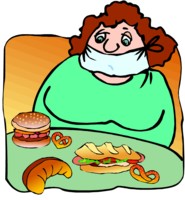|
           
|

|
|
Invasion of the Evil Diet Mongers
 It’s
the year 2012 and after completing their ritual exercise session,
Chase, a 9 year old boy, looks up at his well muscled dad and
asks the inevitable question, It’s
the year 2012 and after completing their ritual exercise session,
Chase, a 9 year old boy, looks up at his well muscled dad and
asks the inevitable question,
“Dad,
why is everybody that we know so fat?”
The
physically fit Dad knew the day would come that he’d be asked
to explain why he was "different," and thankfully
he had the answer, an answer that was chilling, an answer that
he knew was going to alter the course of his son's life. Yes,
Dad knew the real story. He sat down, took a deep breath, and
began . . .
Somewhere
beyond the Milky Way, Snommis, the ruler of the Kaznorg race
announced he’d come to a decision. The threat of extinction
was growing real, and time was running out. Snommis announced
that the inhabitants of their home planet, the planet they
call Faraway, will have to venture beyond their own solar
system if the Kaznorg are to live on.
[ Time out for a
note from Phil . . . if you haven't
yet noticed, I at times struggle with mildly creative yearnings
to spin yarns, to tell tales, to venture off into delusional
escapades for reasons I dare not attempt to answer lest
I come to find out I'm in serious need of therapy. In cases
such as this I indulge these yearnings, but I'll give you
an opportunity to escape. If you click
here you can jump right to the relatively sane part
regarding diet realities . . . if not, read at your
own risk and don't say I didn't warn you ].
The
story continues . . . .
For
the past decade the Kaznorg had been slowly but surely exhausting
their food supply. As anyone born on Faraway knows, Kaznorgs
survive by consuming fat, lots of fat, nothing but fat. The
Kaznorg farmers raised livestock, but since it’s an entirely
different galaxy, their livestock looked nothing like earth’s
cows, chickens, or pigs. The prime “stock” was the Blubbo
which resembled a huge balloon filled with Jello. Up until
the famine began the Blubbo were abundant and reproduced with
great enthusiasm. Then, for reasons only apparent to the Blubbo
themselves, reproduction ceased. The abundant food supply
suddenly became finite and when things started hitting the
critical stage Snommis was driven to initiate the invasion.
 The
Kaznorg rub antennae and make buzzing noises when they are
elated, and when Snommis made the announcement the buzz was
heard around the planet. Kaznorg scientists had been studying
other galaxies and they found Earth, a planet inhabited by
beings made in part of good old delicious fat. Snommis announced
the Kaznorgs will invade Earth, and he had a plan. The
Kaznorg rub antennae and make buzzing noises when they are
elated, and when Snommis made the announcement the buzz was
heard around the planet. Kaznorg scientists had been studying
other galaxies and they found Earth, a planet inhabited by
beings made in part of good old delicious fat. Snommis announced
the Kaznorgs will invade Earth, and he had a plan.
The
invasion would be slow, deliberate, and subtle.
The
plan involved quietly adapting human form and gradually fattening
up the Earth beings, ultimately breeding a new superior type
of livestock so the Kaznorgs can live and flourish. The first
scouts come back with marvelous news. Earth beings, called
humans, have some semblance of intelligence, but little common
sense, so they can easily be persuaded and influenced.
The
invasion began to take shape and soon thereafter a spaceship
landed and the alien beings with yellow paper-like skin and
antennae hid below the Brooklyn Bridge where they used high-tech
equipment to study and monitor the human race. The first mission
was to create an icon, to adopt the form of an earth being
who appeared non-threatening but can be held up on a pedestal
as a guru. Snommis was going to be the first. He volunteered
to take human shape, but the first attempt was . . . ummm
. . . well, a first attempt. He wound up a little too rotund,
had not come to fully grasp gender differences, and he still
had much to learn about human personality.
 When
Snommis, in his new form, was unleashed upon an unsuspecting
Earth public, he needed a new identity. He reversed the letters
of his name and made "Simmons" his surname, as on
Earth the beings were referred to by both first names and
last names. Snommis took on the common first name, "Richard,"
and tried to reach the population through talk shows and infomercials.
He gained some popularity, but too many people began to suspect
something was awry. When
Snommis, in his new form, was unleashed upon an unsuspecting
Earth public, he needed a new identity. He reversed the letters
of his name and made "Simmons" his surname, as on
Earth the beings were referred to by both first names and
last names. Snommis took on the common first name, "Richard,"
and tried to reach the population through talk shows and infomercials.
He gained some popularity, but too many people began to suspect
something was awry.
Earth
beings were often heard saying, "I think Richard Simmons
is from another planet," so Snommis and the scientists,
for fear of being discovered, went back to work. Snommis also,
in the process, found an affection for dancing with oldies
. . . but I digress . . . on with the story . . .
The
Kaznorg researchers observed people walking down the streets
of New York and zeroed in on a chubby fellow with graying
hair and a receding hair line. After much debate the Kaznorg
scientists agreed, this would be an ideal model. Kaznorg surgeons
went to work and within a matter of months they had completed
the transformation. Snikta, one of their most trusted scouts,
was now in human form.
The
Kaznorg Research Group (KRG) continued to monitor earth behavior
and they were amazed by earth’s fascination with old reruns
of Three’s Company. In space alien language Snikta, who now,
in his new form found Kaznorg women a bit less attractive
grew excited and began to buzz so loud bees swarmed KRG headquarters.
Snikta, the being on which the fate of the entire Kaznorg
race rested, issued a command. He shouted, “addddooooooli-hrmphh-krisssseeee.”
That's Kaznorg for, “those earth people seem to like the one
they call Chrissy. Make me a Chrissy look alike.”
With
the completion of a non-threatening stocky balding male and
a very sexy blonde human female, the only factor left was
to choose a command center. A study of Earth traffic flow
indicated South Beach was the place.
The
plan was complete. The Kaznorg will invade Earth. Snikta will
reverse the letters of his name and call himself a doctor,
the replica of Chrissy will sell a thigh-reducing device knowing
it will position her as an expert, and they’ll plant their
spaceship in South Beach to suck people into their trap. The
goal: fatten earth people.
Snikta,
with the letters reversed, became Atkins, and putting the
heading “doctor” before the name added great appeal. Dr. Atkins
released a book telling Americans that they’d need to give
up carbs, full knowing that this strategy in the long run
would create earth beings with the body composition of young
ripe Blubbos. To further confuse these beings, the Chrissy
clone came out with a program she called, “Sommercize” where
she discouraged humans from consuming fats and to make matters
worse, informed them of the hazards of eating proteins and
carbs together. This strategy would of course lead to the
ingestion of small servings made up of low calorie foods leading
to gradual metabolic slowdown. Of course the allure of South
Beach was heightened when the Kaznorg creatively put forth
“The South Beach Diet," an approach contradicting much
of what both the fat eaters and the fat avoiders believed.
Earthlings
were oh so gullible. Their vanity was their weakness, and
as long as they were told that “diets” would make them look
and feel better, they’d ignore evidence to the contrary and
follow Dr. Atkins, Sommercize, and The South Beach Diet blindly,
moving from one to the other without ever recognizing the
perils of metabolic sabotage.
All
was wonderful for the Kaznorgs, and they were getting ready
to abandon Faraway and inhabit their new home, but just around
the turn of the century, people started second guessing the
Atkins idea. They seemed to be realizing that avoiding carbs
wasn't working. This was predictable, so the Kaznorg masterminds
were prepared. They'd simply create a new clone. They'd take
their greatest interplanetary psychologist, Lihp, and ask
him to poison the minds of humans so these fat-storing beings
would feel guilty, miserable, and unhappy with themselves.
These negatively reinforced feelings would no doubt drive
earthlings to, despite their better judgment, revert back
to ineffective calorie deprivation.
Following
the strategy used for Snikta, reversing the letters of the
name and adding the word Dr., the secret weapon was released.
A new clone, one of a bald man with a mustache was let loose.
Dr. Phil emerged targeting America where it was weakest. Through
Oprah!
By
the time 2006 rolled around, the Kaznorg were stealing about
30 billion dollars a year from America’s economy with several
billion pouring in from Europe as well. All looked bleak,
but there was hope.
The father,
exhausted from telling the story, pulled his son close. "Son,"
he continued. "I am part of a secret organization, an
organization committed to battling the Kaznorg." It
was a proud moment when the father opened the secret door and
revealed “The Synergy Room,“ a room where people exercised and
ate correctly consuming supportive meals every 3 - 3 1/2 hours.
"Be
strong, son, the battle continues. The Kaznorg are slick cunning
beings, and they’re growing hungrier by the minute. They continue
to come out with new diets attempting to prevent Earth Beings
from identifying the Fitness Truth, but together we shall defeat
the Kaznorg evil."
The son
took the sacred oath, "I hereby commit to battle the
diets, to maintain a balance between the Right Nutrition, Moderate
Aerobic Exercise, and a Concern for Muscle," and the
father grew teary eyed as his only offspring committed to a
mission initiated by Phil Kaplan, the first to identify the
Kaznorg invasion. Kaplan had since been committed to an insane
asylum, a clever tactic the Kaznorg used as they gradually infiltrated
the population with their cloned doctors and psychologists.
There was
one thing the father had left to do. Ready to hand over the
sacred document, the father looked deeply into his son's eyes
and prepared the young man for the words few had seen. "Phil
Kaplan remains determined to share the fitness truth, despite
the power of his captors. He's a great man, albeit a little
conceited. He's so determined to keep the mission alive that
just before the 2006 capture, he released the following document,
a document that, given time and the right strategy, can save
the world."
The father
sighed, as he knew this was a moment to remember, the moment
he shared The Fitness Truth with his son.
“Son,
once you read this your life will never be the same.”
A
Review of the Latest Spins on Calorie Deprivation
by Phil Kaplan,
2006
Diets. They're
invading and they don't seem to be letting up. Worst of all,
with all of these conflicting dietary offerings, America and
the world are growing fatter and fatter. This document is intended
to provide clarity, to give people back their common sense.
Here, with that in mind, is a review of some of the "popular"
diets.
The French
Women’s Diet
In
2004 the U.S. Census Bureau released statistics from their International
Data Base related to obesity in not only the U.S., but worldwide.
You might be surprised to find out that based on their sampling,
more than 1/3 of France's population falls into the overweight
category. Worse yet, from 1997 to 2003, obesity in France escalated
a whopping 40%! With that said, I think there is some virtue
to the book that drives the "diet," French Women Don't
Get Fat; The Secret of Eating For Pleasure by Mireille Guiliano.
If I can take the liberty of attempting to simplify it's premise,
eat foods you like and observe an approach of moderation. Use
fresh tasty ingredients and don't skip meals. If we limited
the approach to these "tips," there's little to debate.
The challenge lies in America's "just tell me what to do
and I'll do it" mentality. Our population has been so overly
exposed to deprivation plans, we're dealing with a psychology
that needs readjusting. To give the average American dieter
"permission" to eat rich chocolate leads to inner
conflict and confusion. I believe the book is worth reading,
but is it going to offer a solution for American dieters in
search of a solution? I'd have to bet against it. While a book
explaining the virtues of slowly enjoying a lunch in a social
environment may idealistically feed the search for a solution,
it doesn't translate to American lifestyle, pressures, and habits.
The French Women's Diet is not a dietary solution, it's simply
a perspective on a population's relationship with food.
Many
compounds are sold holding collagen protein up as a weight loss
solution. They are accompanied by marketing thrusts that ask
users to take a teaspoon or tablespoon of the formula three
hours before bed on an empty stomach. The FTC has brought charges
against several companies touting collagen protein as a weight
loss solution. Click here for more on Collagen
as a Weight Loss Aid.
Often
called "the most sensible," and sound in its approach
from a healthy eating standpoint, Weight Watchers has gone through
various reinventions going from "exchanges" to "points,"
and more recently their "no counting plan." While
I believe Weight Watchers is a well intentioned organization,
and when compared scientifically to other "diets"
it's a sure bet to come out as "more successful,"
the success I believe is most attributed to their support network.
That doesn't make me an advocate of the approach, as the "programs"
are still based on restricting calories, regardless of the spin,
and when evaluated in terms of long term results, they come
up as having limited success at best. More
Share
Your Diet Experiences - send an email
More below . .
. .
|
What's
Wrong With Cutting Calories?
|
 Diets
for over a century have been built upon the concept of
cutting calories. It is true that if you take in more
calories than the body is going to utilize excesses will
be stored as fat, but that doesn't mean cutting calories
leads to fat loss. The systems of the body are designed
to protect you, and the endocrine system doesn't understand
why you're cutting calories. If you take in fewer calories
than is necessary to sustain metabolism, protective mechanisms
kick in to slow metabolism down. The body will begin to
catabolize (feed off of) muscle tissue in a calorie deprived
state. While this leads to a short term reduction in weight,
muscle is metabolically active tissue. By destroying calorie-burning
tissue, the body reaches a new "set point" where
it requires fewer calories to sustain metabolism. The
outcome - metabolism is slower, the body is going to be
more efficient at storing fat, and the caloric intake
that used to be required for maintenance will not lead
to fat accumulation. Continued calorie deprivation leads
to alterations in thyroid hormone production, increases
in lipoprotein lipase production (a fat-storing enzyme),
alterations in neurotransmission driving people toward
sugars and fats (cravings), and inevitable abandonment
of the diet. I know there's a temptation to believe cutting
calories is sound, but if you look at the evolution of
our population and seek a correlation with the emergence
of calorie-reducing diets, it's clear that as more diets
emerge we as a population become fatter. The diet industry
succeeds primarily because it fails people. If calorie
restriction were in fact a solution, wouldn't the first
diet you tried have "worked?" Here's where it's
important to allow common sense to jump in and to at the
very least open your mind to the possibility that the
solution may lie in a strategy other than the one that
is the most touted and the most lucrative for diet sellers. Diets
for over a century have been built upon the concept of
cutting calories. It is true that if you take in more
calories than the body is going to utilize excesses will
be stored as fat, but that doesn't mean cutting calories
leads to fat loss. The systems of the body are designed
to protect you, and the endocrine system doesn't understand
why you're cutting calories. If you take in fewer calories
than is necessary to sustain metabolism, protective mechanisms
kick in to slow metabolism down. The body will begin to
catabolize (feed off of) muscle tissue in a calorie deprived
state. While this leads to a short term reduction in weight,
muscle is metabolically active tissue. By destroying calorie-burning
tissue, the body reaches a new "set point" where
it requires fewer calories to sustain metabolism. The
outcome - metabolism is slower, the body is going to be
more efficient at storing fat, and the caloric intake
that used to be required for maintenance will not lead
to fat accumulation. Continued calorie deprivation leads
to alterations in thyroid hormone production, increases
in lipoprotein lipase production (a fat-storing enzyme),
alterations in neurotransmission driving people toward
sugars and fats (cravings), and inevitable abandonment
of the diet. I know there's a temptation to believe cutting
calories is sound, but if you look at the evolution of
our population and seek a correlation with the emergence
of calorie-reducing diets, it's clear that as more diets
emerge we as a population become fatter. The diet industry
succeeds primarily because it fails people. If calorie
restriction were in fact a solution, wouldn't the first
diet you tried have "worked?" Here's where it's
important to allow common sense to jump in and to at the
very least open your mind to the possibility that the
solution may lie in a strategy other than the one that
is the most touted and the most lucrative for diet sellers. |
Atkins
No
need to stir up controversy here (as if I haven't already).
I have several articles I've written addressing the Atkins diet
and the one that stirs up the most interesting mix of "Phil
you're an idiot" comments and "thank you for providing
clarity" expressions is the one you'll find by clicking
here. The bottom line . . . there's more to the Atkins Diet
than "just cutting carbs" and there's more to the
healthy fat loss equation than demonizing carbohydrates and
inviting saturated fats.
More
grounded than Atkins, creating important distinctions between
EFA's and saturated fats, and "allowing" for more
carbohydrate leeway, the South Beach diet has an Atkinesque
induction phase. At the onset, you cut carbs to near zero and
the resultant water loss creates the illusion of early weight
loss success. Find more here.
Up
up high in the Himalayan mountains, the Hunza people live to
be 120 years old, they father children in their 90's, and they're
free from disease. Such is the premise upon which unscrupulous
operators who hold up a bread recipe as the Hunza secret build
their empires. They simply ask that you fold up a nice crisp
American twenty-dollar bill in an envelope, affix postage, and
send it overseas to a P.O. Box. If you're tempted . . . you
better read a bit more about Hunza
bread.
Take
the Atkins Diet, drench it in Macadamia Nut oil, and you have
the book by Fred Pescatore. It seems that if there's a place
that finds its way into the public eye as "cool" or
"trendy," a diet will be named after it. It was only
a matter of time until the Hamptons made the list.
This 1985
book was authored by Harvey and Marilyn Diamond. It sold over
a million copies and still attracts new followers both in
its original form and in reproductions and imitations by others
who claim to find virtue in the Diamonds' approach. Scientists
and mainstream nutritionists condemned not only the book,
but the author's prefix of "Dr." in front of his
name. Dr. Harvey Diamond received his Ph.D. from a non-accredited
correspondence school, The American College of Health Science
in Austin, Texas, later named the Life Sciences Institute.
The school and its founder, T.C. Fry, who passed away in 1996,
faced its fair share of scrutiny and controversy. You can
research the school and the founder and form your own opinions.
The premise that drives Fit For Life is that people gain weight
because they consume their proteins and carbohydrates together.
The authors go on to explain that the incomplete digestion
of foods, as a result of the battle between enzymes specific
to protein digestion and those specific to carb digestion,
leads to the build up of toxins that ultimately contribute
to fat accumulation. The idea of "food combining,"
making meals specific to one macronutrient, originated over
100 years ago, way before nutritional science developed enough
sophistication to bring the level of understanding of nutritional
biochemistry we have today, and it was an unfounded theory
then as it is now. The reality is, the body is very efficient
at digesting proteins and carbs together (in fact amino acids,
the building blocks of protein are transported along with
glucose, the building blocks of carbohydrate foods), there
is a thermic effect that leads to metabolic benefit when meals
contain combinations of macronutrients, and if people lose
weight with this approach it's yet another "diet"
that creatively leads to calorie deprivation. The diet suggests
eating only fruit from the time you wake until noon, consuming
protein-only meals and carb-only meals between noon and five,
and then going back to fruit until bedtime. Fruits are low
in calories and water dense, protein only meals are far lower
in calories than a supportive combination of macronutrients,
and metabolic slowdown is pretty much a guarantee if the Fit
For Life diet is combined with an exercise regimen for any
given period of time. Muscle loss will translate to pounds
lost as measured by the scale, but the long term metabolic
destruction can lead to significant challenges with fat accumulation
in the future. This approach reemerges often in books release
by celebrities and pseudo experts with little or no expertise
in healthfully reshaping bodies.
Share
Your Diet Experiences - send an email
More below .
. . .
|
Red
Flags and Warning Signs
|
|

|
Beware
Diets that de-emphasize the need for exercise
Beware
Diets that purport you'll lose more than 2 pounds per
week
Beware
Diets that suggest a specific food is
in and of itself a miraculous solution
Beware
the Diets that severely restrict calories
|
This
book was penned by David Zinczenko, the editor of Men's Health.
It's good. It's sound. It shares the approach that has worked
for athletes for years, the approach that dieters continue to
shun although it's sensible, proven, and healthful. The Abs
Diet does not present diet without exercise, and it does align
very closely with the approach I've used for two decades. When
people who are closely connected with the programs that fitness
and physique athletes use healthfully, it's no wonder "frequent
eating" and "strength training" are always underlying
success elements. To give it a unique spin, Zinczenko outlines
12 Power Foods, which as you'll see when I get to the Sonoma
Diet, is a new term authors use to present foods as . . . well
. . . powerful. Interestingly, comparing various books with
Powerfood lists brings recognition that the lists have few similarities.
The Abs Diet presents the following foods as winners: Almonds
and Other Nuts (with skins intact), Beans and Legumes, Spinach
and Green Vegetables (note that so far taking the first letters
of each group spells out ABS), Dairy: Fat-free or low-fat milk,
yogurt, cheese, cottage cheese, Instant Oatmeal: unsweetened,
Eggs, Turkey and lean meats (now we've spelled out DIET), Peanut
Butter - sugar-free, Olive Oil, Whole-Grain Breads and Cereals,
Extra-Protein (Whey) Powder, Raspberries and Other Berries (completes
the acronym ABS DIET POWER). The list is cute, the books teachings
are valid.
Nobody
can question Slim-Fast's marketing ability. The Slim-Fast section
in any supermarket is enough to indicate they're selling lots
and lots of product. The premise is simple. Replace high calorie
meals with lower calorie shakes. This is yet another methodology
for entering a state of calorie deprivation. Slim-Fast utilized
the marketing tagline "Weight Loss Therapy in the Prevention
and Treatment of Obesity." That's powerful. "Therapy"
sounds medical. "Prevention" suggests that even if
you're not obese it will help you avoid ever becoming so. A
look at the ingredients is enough to realize that marketing
more than effectiveness has been the key to Slim-Fast's growth.
Compare the label to the label on a bottle of Yoo-Hoo. You'll
be surprised by the similarities. The Slim-Fast Diet Plan is
of course a vehicle for selling meal replacement shakes and
bars. Veggies, shakes, fruit, Slim-Fast snack bars, and gelatin
are the mainstays of this calorie restrictive diet. More
Here
is testimony to the fact that celebrity can make virtually anybody
successful as a weight loss expert. Oprah, who has probably
had the most public yo-yo experience we've ever witnessed, turned
Dr. Phil McGraw into a celebrity. He hadn't any proven expertise
in helping people find physical health or weight loss, but he
had proven that people would follow his advice. His book was
released with a great deal of hype and I remember watching the
highly promoted TV show launching The Ultimate Weight Loss Solution.
I attempted to watch through the eyes of someone who had struggled
with weight loss. I heard Dr. Phil tell a teenage girl who wanted
to lose weight so she can fit into the cool clothes her friends
wear that she should "pick a Get Real weight." I then
heard him tell her mother to learn to appreciate her other traits
such as her sense of humor and her intelligence. Where's the
weight loss solution? The book is a rehashing of everything
we've heard from the American Dietetic Association for years.
From a nutritional standpoint, nothing new, nothing revolutionary.
McGraw talks about behavior change and rewiring the thought
highways in your brain and goes on to address body image, but
the book isn't titled, "being comfortable in the body you're
in." It's titled "The Ultimate Weight Loss Solution."
It may have its place in the self-help section of a bookstore,
and Dr. Phil clearly has expertise in helping people better
themselves, but let's not open the door for anyone with expertise
in any field to become a weight loss expert. As a final note
regarding this book, the author ventures into a place where
ethics may be questionable. The book directs people to buy supplements
and the supplements recommended are nothing more than multivitamins,
herbs, and soy extracts which haven't any actual evidence as
weight loss aids. Shortly after the book was released, Dr. Phi's
line of supplements hit the shelves.
As
far as diet books go, I can offer a good amount of praise for
this one. Dr. Connie Gutterson is an R.D. so she clearly has
expertise in the nutritional arena. The book uses California
wine country as a substitute for South Beach (there are many
similarities between the South Beach and Sonoma Diets) and presents
the dietary approach in three waves. To begin applying Gutterson's
approach, you must rid your world of refined and processed foods,
and that's a very good thing. She suggests natural food choices.
She suggests nutrient complete meals. There are lots of menu
options and you aren't directed to rely on shakes or bars. You
eat. You just eat better. She designs meals that contain proteins,
grains, and veggies (very much in line with my supportive eating
guidelines of lean protein, starchy carb, fibrous carb) and
she builds her recommendations around 10 "power foods,"
almonds, bell peppers, broccoli, grapes, strawberries, whole
grain, olive oil, blueberries, spinach and tomatoes (you'll
note it's a different list than the Abs Diet, but clearly some
links). Gutterson clearly promotes the distinction between essential
fats and the less supportive fats. I do have some areas where
I'd open a door for debate, such as the allowances for wine
but the forbidding of white potatoes, but for the most part
I find the book sensible and valuable. It doesn't make a case
for the "synergy" that is necessary for metabolism
boosting and optimal fat loss, but it doesn't hold itself up
as a fitness book as much as a healthy eating book, and I believe
it delivers precisely what it promises.
I've
found the Zone to be extremely valuable in helping people recognize
that "eating right" isn't about avoidance as much
as it is about getting the right nutrients into your body in
some semblance of balance with the right frequency. It does
make a strong and valid case for the negative impact simple
sugars have upon insulin production, pancreatic function, and
the importance of balancing protein and quality carbs at each
meal. Those are all virtues. Where it becomes challenging is
in its reliance upon the concept of "Glycemic Index."
Glycemic Index (GI) is a reading, a number, assigned to a specific
food based upon the level of impact that food has on blood sugar
when it's consumed by itself. Because you can't look at a food
and know its GI, followers of the Zone become reliant upon charts.
It should also be noted that consuming carbs and proteins together
renders the GI measurement invalid since the proteins slow the
release of sugars. Ice cream has a lower glycemic index than
a potato because the proteins and fats slow the rush of glucose
into the bloodstream. Zone meals are constructed proportionately
in "blocks." For those who are comfortable weighing,
measuring, and referring to charts, the Zone is valuable. I
do believe some of the extrapolations of the Zone commandments
and some of the support information to be myopically presented,
and some of the "science" less relevant than the author
would like readers to believe they are, but there's no doubt
exercisers will find body composition shifts shifting from "typical
American eating" to a Zone style diet plan.
This
book, by nutritional expert and physician Dr. Leo Galland, is
current in sharing legitimate science and it clearly explains
the role of the hormonal messenger leptin in weight control.
Unlike other books which focus on restriction and weight loss,
Galland addresses cravings, satiety, and metabolism which are
issues the weight-loss wanting public must understand if we're
going to see a positive shift in obesity issues. This isn't
the first book to address controlling and managing leptin production.
Mastering Leptin by Byron Richards also does a nice job of presenting
leptin's role to a mainstream audience. There are some very
nice things about the way the "diet approach" is presented.
It isn't restrictive, it doesn't throw carbs out the window,
it is sensible in its approach and it not only expresses the
need to incorporate exercise, it also addresses stress reduction.
The dual themes are health and weight management thus there
is important inclusion of Omega-3's, micronutrients, and "superfoods"
(another spin on powerfoods) that help to battle disease. I
am not 100% comfortable with the three phases of the diet and
the "number of pounds" readers can expect to lose,
but I think it more than makes up for it with its very clear
and understandable explanations of hormonal biochemistry, explanations
that can help many people frustrated with prior weight loss
attempts understand some of their unrecognized challenges.
A new
book written by David L. Katz, MD, MPH, FACPM, FACP. Lots
of letters after his name and his credentials aren't those
purchased through correspondence schools. Katz is associate
professor of public health, director of the Yale Prevention
Research Center, and associate director of nutrition science
at the Rudd Center for Food Policy and Obesity at Yale University.
Credible? No question. His book takes an element of nutrition
that may be underemphasized, namely sensory stimulation. He
shares compelling explanation of the hypothalamus' role in
organizing a chain or neurochemical events that regulate appetite,
cravings, and satiety, and I can't find a single flaw in his
explanations. The book then offers a nice mix of recipes with
the focus being, rather than combining a surplus of sweet
salty and savory flavors that overstimulate appetite, limiting
stimulation to flavors that lead to regulating appetite and
managing chemical-driven impulse. So do I think this is the
diet book that will solve America's fat challenge? No. I think
it makes for good reading. I think it's a novel and well-founded
approach. I also think the outcome of following the resultant
regimen will be short-lived attempts with what promises to
be a new "fad" diet. Eat according to the diet plan
and you'll eat "better" than most Americans, and
eating better can certainly lead to improvement . . . it's
just that there's more to long term body composition shifts.
The Flavor Point Diet does approach things scientifically,
but I don't see it being "real-world" enough, nor
do I see it addressing the importance of the combination of
physical activity with a sensible eating plan for long term
results.
My Motives
Let me make
a few points here before anyone rips a hole in me for sharing
my opinions on what might be their favorite diet. My intention
is not to bash anything or anybody. My intention is not to cover
"every diet" in a single article, as a search on Amazon.com
just came up with 7,969 available book titles featuring the
word "diet." I've been in the business of helping
people find health and fitness for over two decades and have
a highly respectable success rate. My educational expertise
is documented on the exercise side of things, but as a consumer
advocate I've interviewed hundreds of biochemists, nutrition
experts, M.D.'s, anti-aging specialists, authors, athletes,
coaches, and psychologists, and with all of that input and a
careful and ongoing study of research I've managed to form some
relatively educated opinions. With that said I consider myself
a lifetime learner and I invite feedback
whether it leans toward praise or criticism. As more people
share their experiences, I continue to expand my understanding
of the topics most controversial and those that are followed
by the greatest volume of controversy. If anything I've said
in this piece upsets you, rather than sending me a venomous
email, explain where I might be in error and provide me a resource
to obtain additional information. I've found, based on both
life experience and extensive research, there is no greater
fitness and fat loss solution than the combination of supportive
nutrition incorporating frequent thermic meals, moderate aerobic
exercise, and a commitment to strength training. This is not
an approach specific to athletes. I've had over 40,000 people
from all ages categories and all fitness levels go through my
TRANSFORM! program and have had an astounding success rate in
helping people from every walk of life with my 21
Day Journey to Excellence. All of my programs are designed,
not as quick fixes, but for lasting
results. All of my programs are offered with an unconditional
money back guarantee, and I'll continue to strive to uncover
and share the fitness truth until . . . . well . . . until space
aliens imprison me or obesity becomes a thing of the past.
 |
|
Articles Worth Checking Out:
|
|
Also
be sure to visit the following pages:
[
Home ] [ Site
Menu ] [ For Fitness Professionals
] [ Superstore ] [ Update
Menu ] [ Ask
Phil
]
[ Small
Group Workshops ] [ Programs
] This
site is designed and operated by Phil Kaplan
Phil Kaplan's Fitness is located at
3132 Fortune Way, #D1
Wellington, Florida 33414
The TOLL-FREE Product Order Line is 1 800 552-1998
The Direct Office Number is 561 204-2014
The Fax Number is 561 204-2184
e-mail phil@philkaplan.com

|
|

